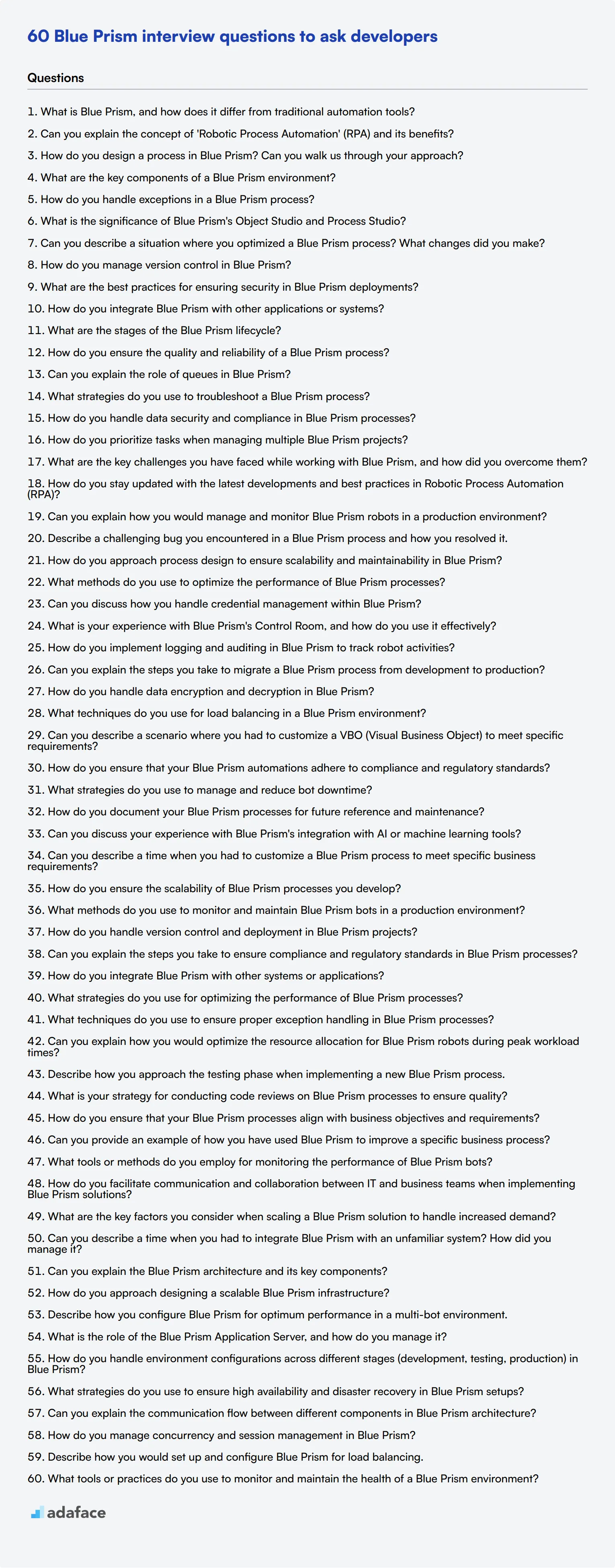Hiring the right Blue Prism developers is crucial for successful process automation projects. Effective interview questions help recruiters and hiring managers assess candidates' skills, experience, and problem-solving abilities accurately.
This blog post provides a comprehensive list of Blue Prism interview questions tailored for different experience levels and specific areas of expertise. From basic concepts to advanced topics, these questions cover the full spectrum of Blue Prism knowledge and skills.
By using these interview questions, you can identify top Blue Prism talent and make informed hiring decisions. Consider complementing your interviews with a Blue Prism skills test to gain a more holistic view of candidates' capabilities.
Table of contents
10 Blue Prism interview questions to initiate the interview
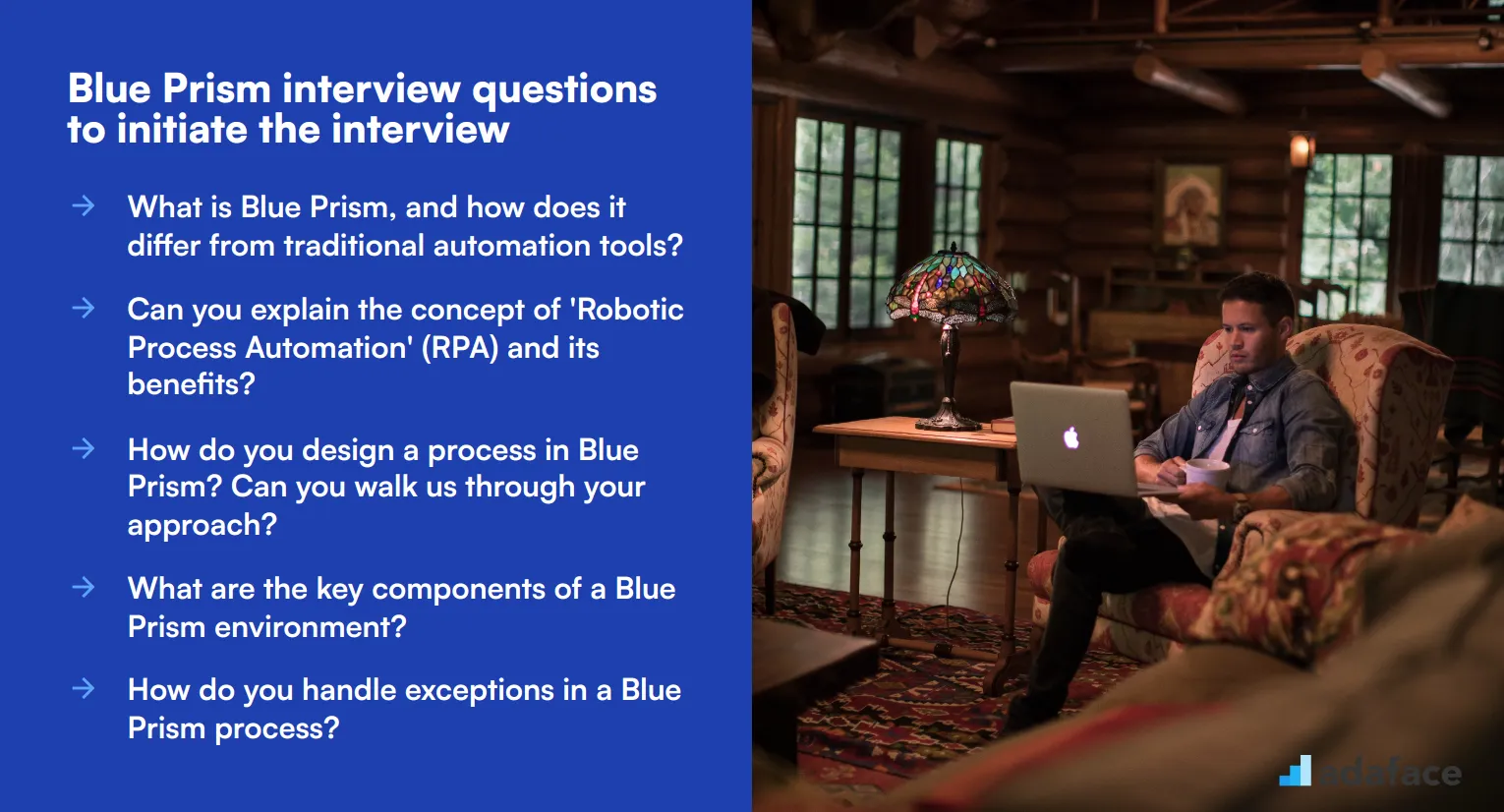
To gauge whether candidates possess the essential skills and knowledge in Blue Prism, you can utilize this list of targeted interview questions. These questions are designed to assess both foundational understanding and practical application, making them a valuable tool during the hiring process for roles like software developer.
- What is Blue Prism, and how does it differ from traditional automation tools?
- Can you explain the concept of 'Robotic Process Automation' (RPA) and its benefits?
- How do you design a process in Blue Prism? Can you walk us through your approach?
- What are the key components of a Blue Prism environment?
- How do you handle exceptions in a Blue Prism process?
- What is the significance of Blue Prism's Object Studio and Process Studio?
- Can you describe a situation where you optimized a Blue Prism process? What changes did you make?
- How do you manage version control in Blue Prism?
- What are the best practices for ensuring security in Blue Prism deployments?
- How do you integrate Blue Prism with other applications or systems?
8 Blue Prism interview questions and answers to evaluate junior developers
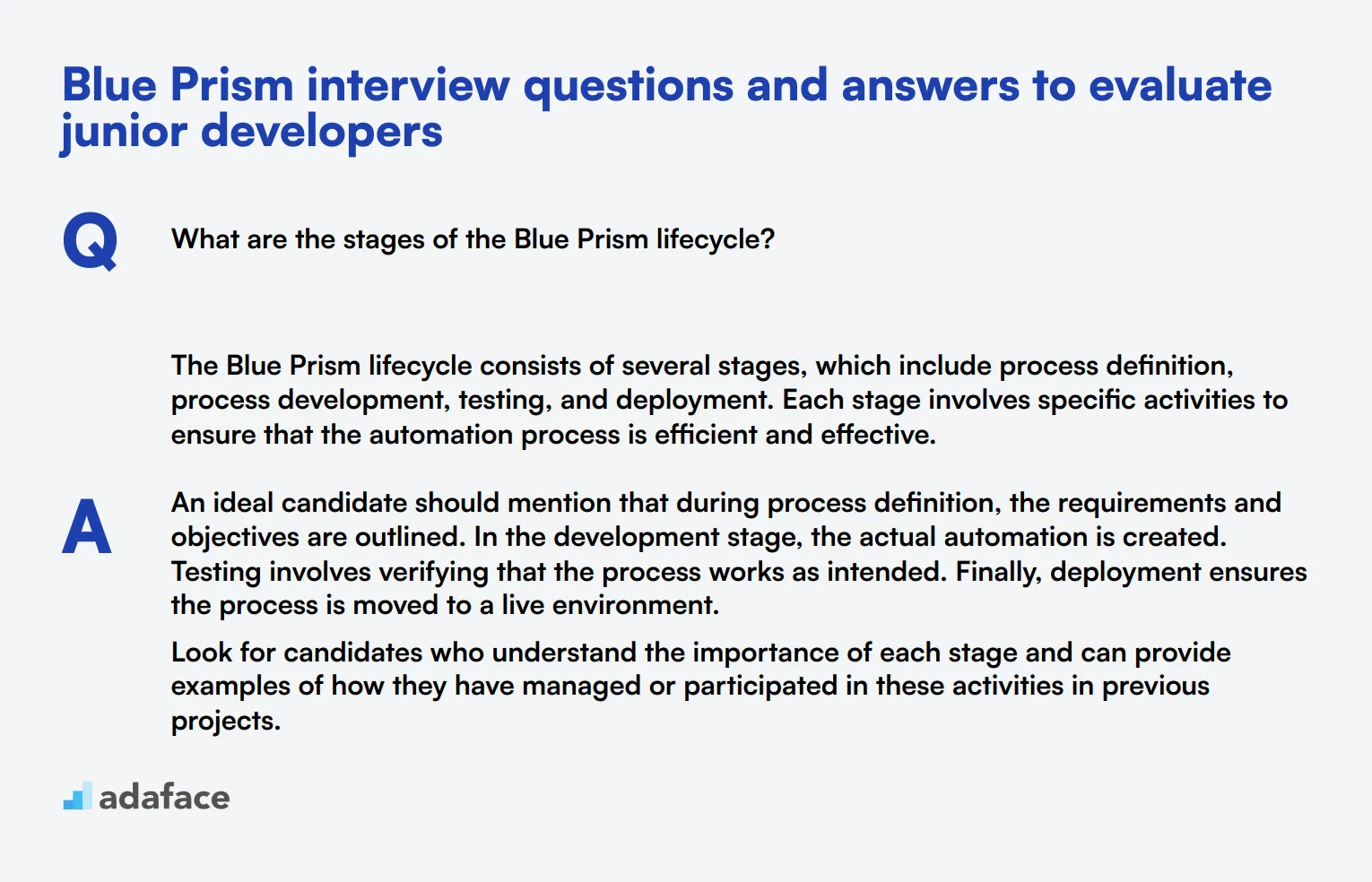
To evaluate the practical knowledge and problem-solving skills of junior Blue Prism developers, use these interview questions. They will help you identify candidates who possess a solid understanding of Blue Prism's fundamental concepts and can apply them effectively in real-world scenarios.
1. What are the stages of the Blue Prism lifecycle?
The Blue Prism lifecycle consists of several stages, which include process definition, process development, testing, and deployment. Each stage involves specific activities to ensure that the automation process is efficient and effective.
An ideal candidate should mention that during process definition, the requirements and objectives are outlined. In the development stage, the actual automation is created. Testing involves verifying that the process works as intended. Finally, deployment ensures the process is moved to a live environment.
Look for candidates who understand the importance of each stage and can provide examples of how they have managed or participated in these activities in previous projects.
2. How do you ensure the quality and reliability of a Blue Prism process?
Ensuring quality and reliability in a Blue Prism process involves thorough testing, including unit testing, integration testing, and user acceptance testing. It also requires regular monitoring and maintenance to identify and resolve any issues that arise post-deployment.
Candidates might mention the use of best practices like handling exceptions properly, using clean and readable code, and documenting the process thoroughly. They may also discuss tools or methods they use for continuous monitoring and logging.
Strong responses should highlight a systematic approach to testing and quality assurance, as well as a proactive attitude towards maintenance and improvement.
3. Can you explain the role of queues in Blue Prism?
Queues in Blue Prism are used to manage and distribute work items to different bots. They help in balancing the load and ensuring that tasks are processed efficiently. Each work item in a queue represents a unit of work that needs to be completed by a bot.
An ideal candidate should mention that queues allow for prioritization and can be monitored to track the progress and status of work items. They may also discuss how queues can be configured and managed to optimize performance.
Look for candidates who can provide examples of how they have used queues to manage workloads effectively and can explain the benefits of using them in an automation process.
4. What strategies do you use to troubleshoot a Blue Prism process?
Troubleshooting a Blue Prism process often involves several steps: identifying the issue, examining the logs, and isolating the problem by testing different parts of the process. Candidates should mention that they use Blue Prism's debugging tools to step through the process and observe where it fails.
They might also talk about analyzing error messages, checking for common issues like incorrect configurations or data problems, and consulting documentation or support resources when needed.
An ideal response should demonstrate a methodical approach to troubleshooting, with examples of how they have successfully resolved issues in the past. This shows their ability to handle unexpected problems effectively.
5. How do you handle data security and compliance in Blue Prism processes?
Handling data security and compliance in Blue Prism involves implementing strict access controls, encrypting sensitive data, and following best practices for data handling and storage. Processes should comply with relevant regulations, such as GDPR or HIPAA, depending on the industry.
Candidates should discuss using Blue Prism's built-in security features, such as user roles and permissions, and integrating with secure systems for data storage and transmission. They may also mention regular audits and reviews to ensure ongoing compliance.
Look for candidates who understand the importance of data security and can provide examples of how they have implemented security measures in their automation projects.
6. How do you prioritize tasks when managing multiple Blue Prism projects?
Prioritizing tasks in multiple Blue Prism projects involves assessing the urgency and impact of each task, setting clear deadlines, and allocating resources efficiently. Candidates should mention using project management tools and techniques to keep track of progress and ensure that all tasks are completed on time.
They might also discuss the importance of communication and collaboration with team members and stakeholders to align priorities and address any issues that arise.
An ideal candidate will demonstrate strong organizational skills and the ability to manage multiple priorities effectively. Examples of past experiences where they successfully managed multiple projects can be a good indicator of their capability.
7. What are the key challenges you have faced while working with Blue Prism, and how did you overcome them?
Common challenges when working with Blue Prism include handling complex processes, integrating with different systems, and managing exceptions effectively. Candidates should describe specific instances where they encountered these challenges and the strategies they used to overcome them.
They might talk about breaking down complex processes into smaller, manageable components, using custom integration techniques, or implementing robust error-handling mechanisms.
Look for candidates who can provide concrete examples and demonstrate problem-solving skills. Their ability to learn from challenges and improve their processes is a key indicator of their potential for growth and success in your organization.
8. How do you stay updated with the latest developments and best practices in Robotic Process Automation (RPA)?
Staying updated with the latest developments and best practices in RPA involves continuous learning through online courses, webinars, and industry conferences. Candidates should mention following relevant blogs, forums, and social media channels to keep abreast of new trends and technologies.
They might also discuss participating in professional networks and communities, such as LinkedIn groups or local RPA meetups, to share knowledge and learn from peers.
An ideal candidate will demonstrate a proactive approach to learning and professional development. This indicates their commitment to staying current in a rapidly evolving field and their ability to bring innovative solutions to your team.
15 intermediate Blue Prism interview questions and answers to ask mid-tier developers.
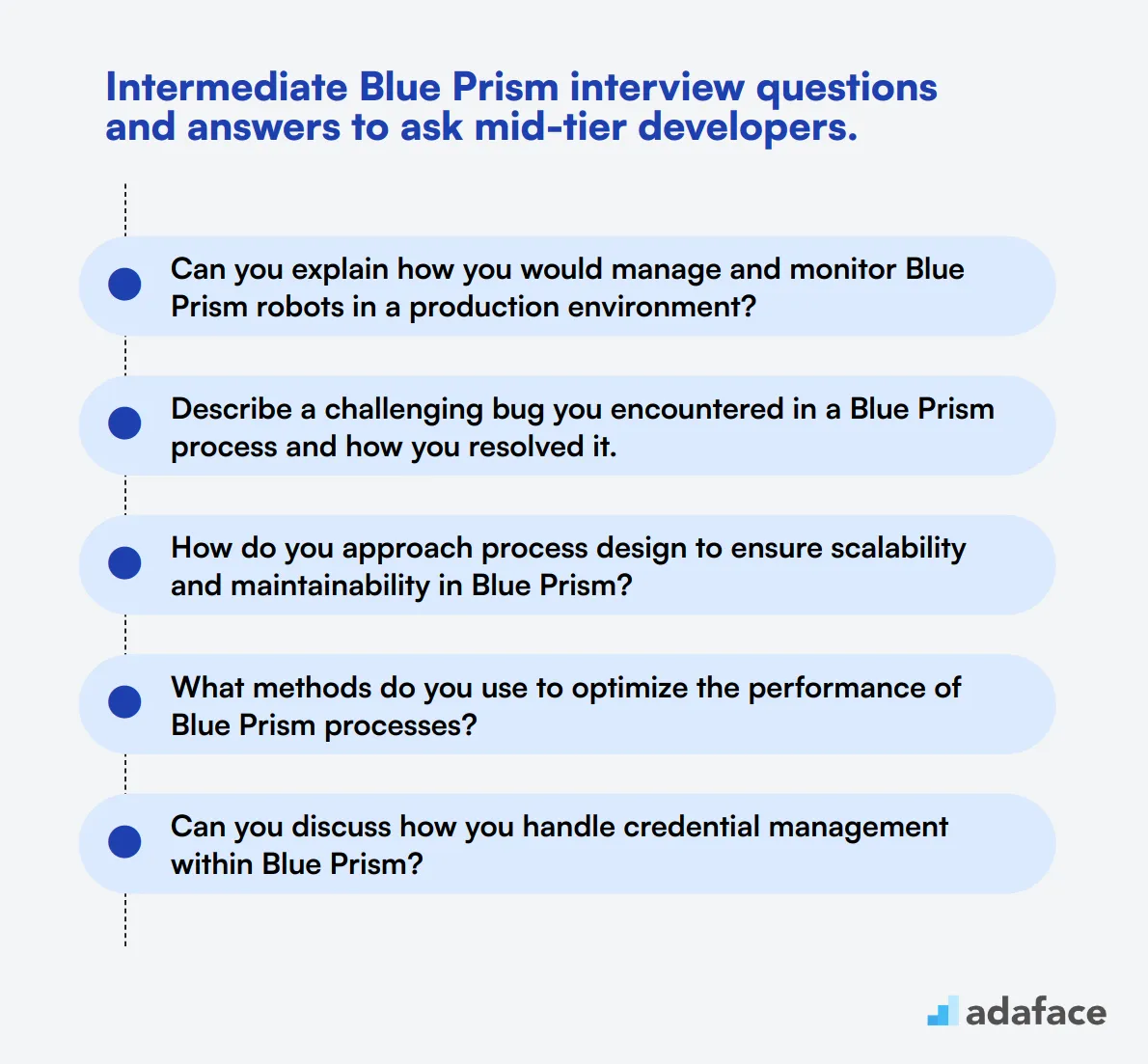
To evaluate the proficiency and problem-solving skills of mid-tier Blue Prism developers, ask them some of these 15 intermediate interview questions. These questions are designed to gauge their ability to handle more complex scenarios and ensure they align with your team's needs. For more on what to look for in developers, check out job descriptions.
- Can you explain how you would manage and monitor Blue Prism robots in a production environment?
- Describe a challenging bug you encountered in a Blue Prism process and how you resolved it.
- How do you approach process design to ensure scalability and maintainability in Blue Prism?
- What methods do you use to optimize the performance of Blue Prism processes?
- Can you discuss how you handle credential management within Blue Prism?
- What is your experience with Blue Prism's Control Room, and how do you use it effectively?
- How do you implement logging and auditing in Blue Prism to track robot activities?
- Can you explain the steps you take to migrate a Blue Prism process from development to production?
- How do you handle data encryption and decryption in Blue Prism?
- What techniques do you use for load balancing in a Blue Prism environment?
- Can you describe a scenario where you had to customize a VBO (Visual Business Object) to meet specific requirements?
- How do you ensure that your Blue Prism automations adhere to compliance and regulatory standards?
- What strategies do you use to manage and reduce bot downtime?
- How do you document your Blue Prism processes for future reference and maintenance?
- Can you discuss your experience with Blue Prism's integration with AI or machine learning tools?
7 advanced Blue Prism interview questions and answers to evaluate senior developers
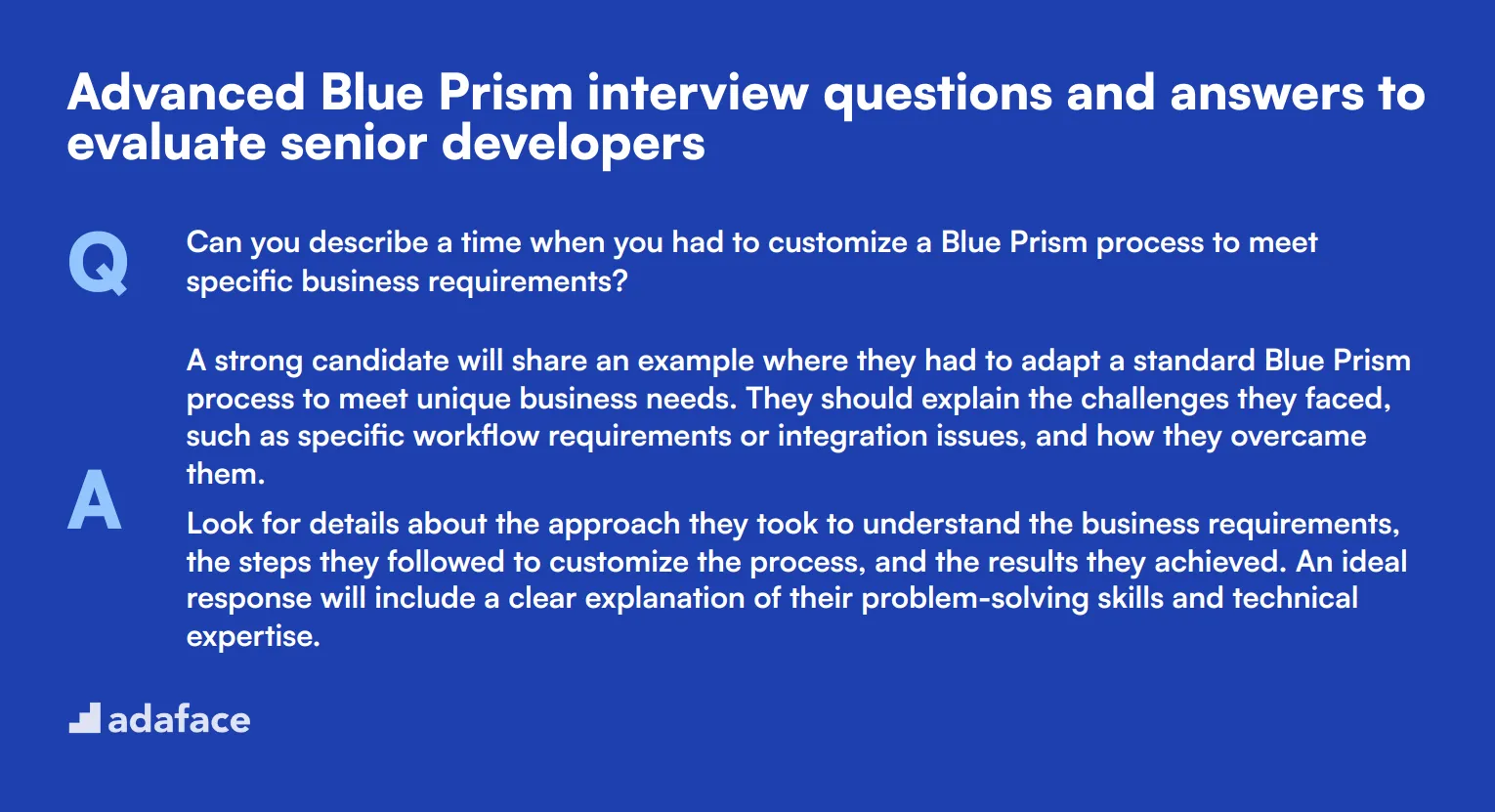
To evaluate the advanced skills and experience of senior Blue Prism developers, use these carefully curated interview questions. Whether you're looking to dive deep into their problem-solving abilities or assess their expertise in handling complex scenarios, these questions will help you identify the perfect candidate for your team.
1. Can you describe a time when you had to customize a Blue Prism process to meet specific business requirements?
A strong candidate will share an example where they had to adapt a standard Blue Prism process to meet unique business needs. They should explain the challenges they faced, such as specific workflow requirements or integration issues, and how they overcame them.
Look for details about the approach they took to understand the business requirements, the steps they followed to customize the process, and the results they achieved. An ideal response will include a clear explanation of their problem-solving skills and technical expertise.
2. How do you ensure the scalability of Blue Prism processes you develop?
Candidates should discuss strategies they use to design scalable Blue Prism processes. This could include modular design approaches, efficient use of queues, and ensuring that processes are not tightly coupled to specific environments or systems.
They should also mention any best practices they follow, such as regular code reviews and performance testing, to ensure that processes can handle increased loads without degradation. An ideal answer would also touch on their experience with scaling processes in real-world scenarios.
3. What methods do you use to monitor and maintain Blue Prism bots in a production environment?
A well-rounded answer will highlight the importance of monitoring tools and techniques to ensure the smooth operation of Blue Prism bots. Candidates might mention using dashboards, alerts, and regular health checks to keep track of bot performance.
They should also discuss their approach to handling issues as they arise, such as troubleshooting errors and performing maintenance tasks to minimize downtime. Look for candidates who can demonstrate a proactive approach to bot management and a good understanding of operational best practices.
4. How do you handle version control and deployment in Blue Prism projects?
Candidates should explain their approach to version control, which may include using tools like Git or Blue Prism's built-in versioning features. They should describe their methods for managing different versions of processes and objects, ensuring that changes are tracked and documented.
When discussing deployment, they should mention strategies for moving processes from development to staging and production environments, including testing and validation steps. An ideal candidate will emphasize the importance of maintaining a robust version control and deployment strategy to ensure process integrity and reliability.
5. Can you explain the steps you take to ensure compliance and regulatory standards in Blue Prism processes?
A good answer will include a discussion of the candidate's understanding of relevant compliance and regulatory requirements. They should explain how they incorporate these requirements into their process design and development, such as through data encryption, access controls, and audit trails.
Look for candidates who can provide specific examples of compliance measures they have implemented and how they ensure that processes remain compliant over time. An ideal response will demonstrate their commitment to maintaining high standards of security and compliance in all their work.
6. How do you integrate Blue Prism with other systems or applications?
Candidates should discuss their experience with various integration methods, such as APIs, databases, and web services. They should explain their approach to designing and implementing integrations, including any challenges they faced and how they overcame them.
An ideal candidate will provide specific examples of successful integrations they have performed, highlighting their technical skills and ability to work with different systems. Look for details about their understanding of integration best practices and their ability to ensure seamless communication between Blue Prism and other applications.
7. What strategies do you use for optimizing the performance of Blue Prism processes?
Candidates should be able to articulate the importance of performance optimization in Blue Prism processes. They might mention techniques such as streamlining workflows, reducing unnecessary steps, and using efficient data handling methods.
They should also discuss their experience with performance monitoring and tuning, including tools and metrics they use to assess process performance. An ideal response will demonstrate their ability to identify performance bottlenecks and implement effective optimization strategies to ensure high-performing processes.
10 Blue Prism interview questions about process automation
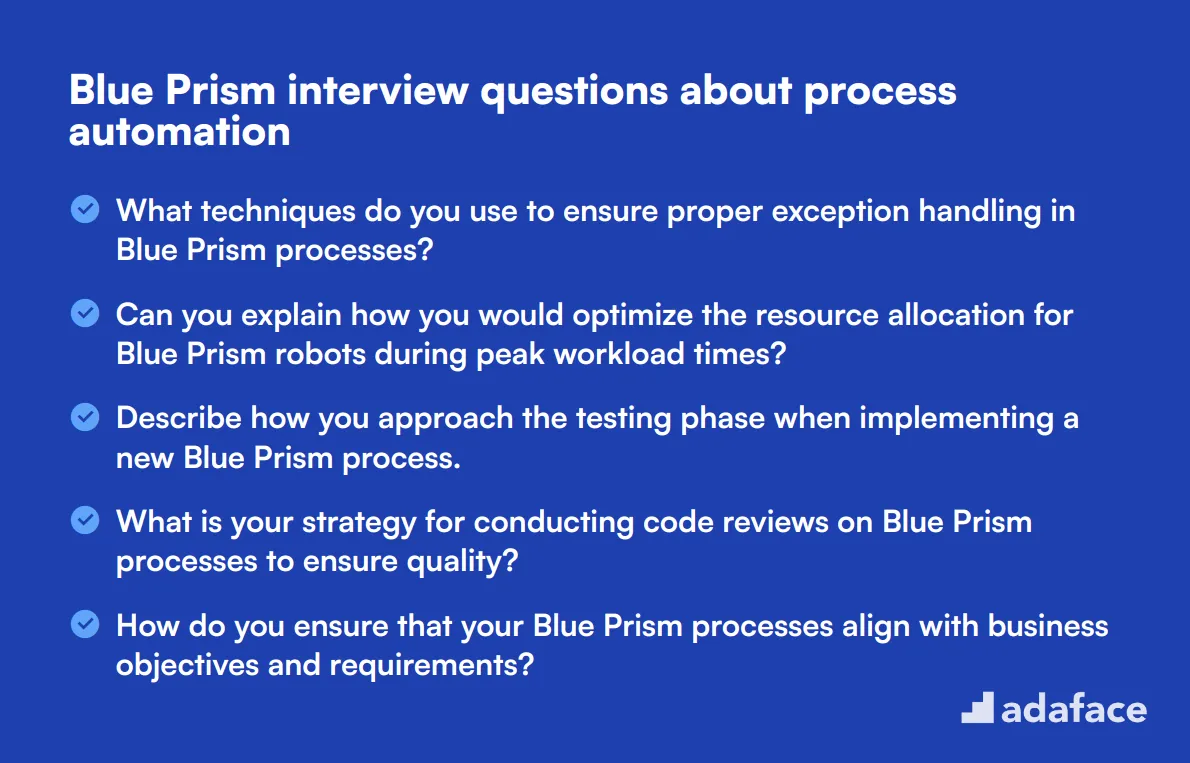
To identify candidates with the right skills for process automation using Blue Prism, consider asking some of these targeted interview questions. They will help you assess the applicant’s understanding of essential concepts and their practical experience in the field of automation.
- What techniques do you use to ensure proper exception handling in Blue Prism processes?
- Can you explain how you would optimize the resource allocation for Blue Prism robots during peak workload times?
- Describe how you approach the testing phase when implementing a new Blue Prism process.
- What is your strategy for conducting code reviews on Blue Prism processes to ensure quality?
- How do you ensure that your Blue Prism processes align with business objectives and requirements?
- Can you provide an example of how you have used Blue Prism to improve a specific business process?
- What tools or methods do you employ for monitoring the performance of Blue Prism bots?
- How do you facilitate communication and collaboration between IT and business teams when implementing Blue Prism solutions?
- What are the key factors you consider when scaling a Blue Prism solution to handle increased demand?
- Can you describe a time when you had to integrate Blue Prism with an unfamiliar system? How did you manage it?
10 Blue Prism interview questions about technical architecture
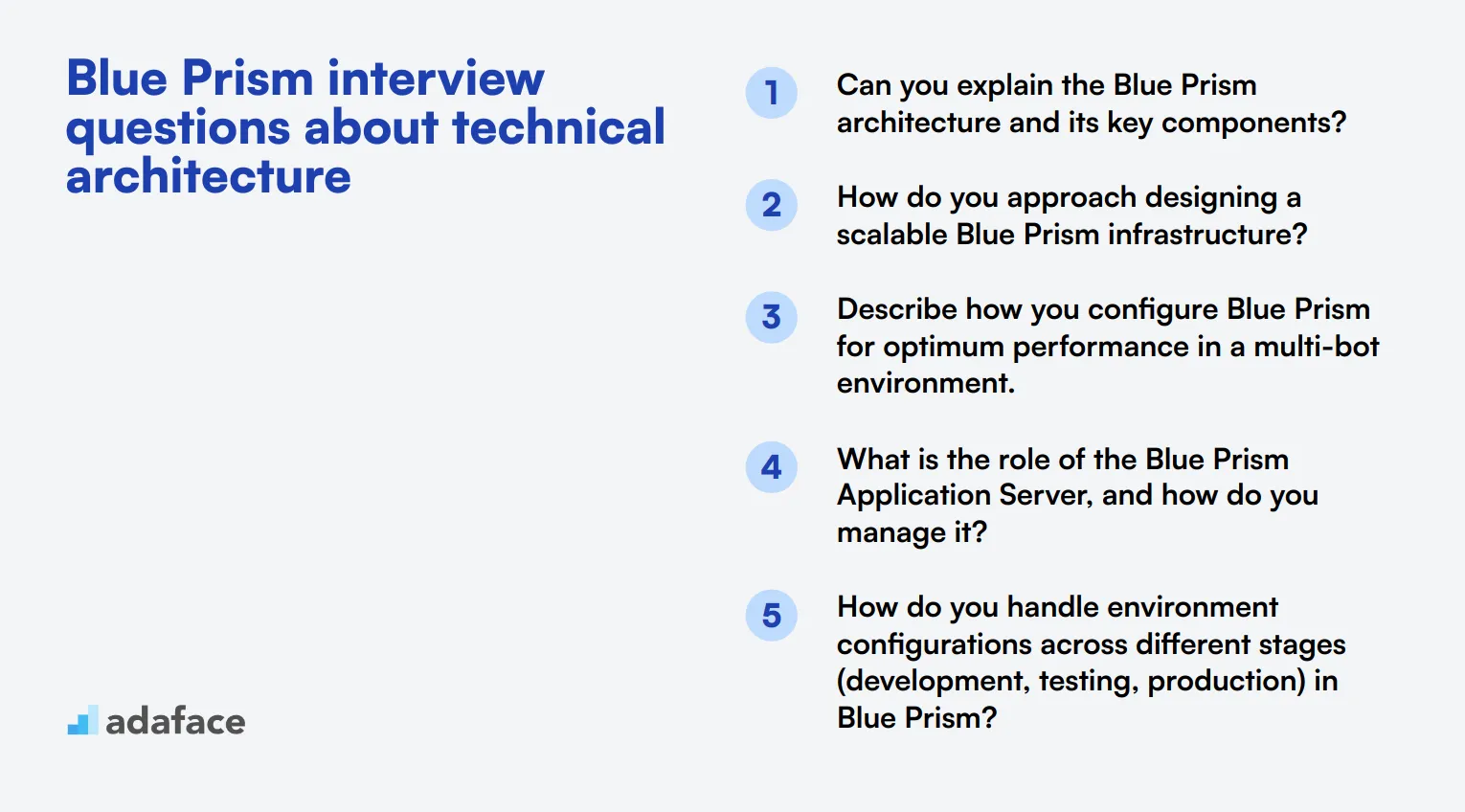
To determine whether your applicants possess the necessary skills and expertise in Blue Prism's technical architecture, use these targeted interview questions. This list will help you identify candidates who can effectively design, implement, and manage Blue Prism solutions, ensuring they align with your business objectives and compliance standards. For more detailed job descriptions, you might find application developer job description useful.
- Can you explain the Blue Prism architecture and its key components?
- How do you approach designing a scalable Blue Prism infrastructure?
- Describe how you configure Blue Prism for optimum performance in a multi-bot environment.
- What is the role of the Blue Prism Application Server, and how do you manage it?
- How do you handle environment configurations across different stages (development, testing, production) in Blue Prism?
- What strategies do you use to ensure high availability and disaster recovery in Blue Prism setups?
- Can you explain the communication flow between different components in Blue Prism architecture?
- How do you manage concurrency and session management in Blue Prism?
- Describe how you would set up and configure Blue Prism for load balancing.
- What tools or practices do you use to monitor and maintain the health of a Blue Prism environment?
Which Blue Prism skills should you evaluate during the interview phase?
While it's impossible to assess every aspect of a candidate's Blue Prism expertise in a single interview, focusing on key skills can provide valuable insights. The following core competencies are particularly important when evaluating Blue Prism professionals.
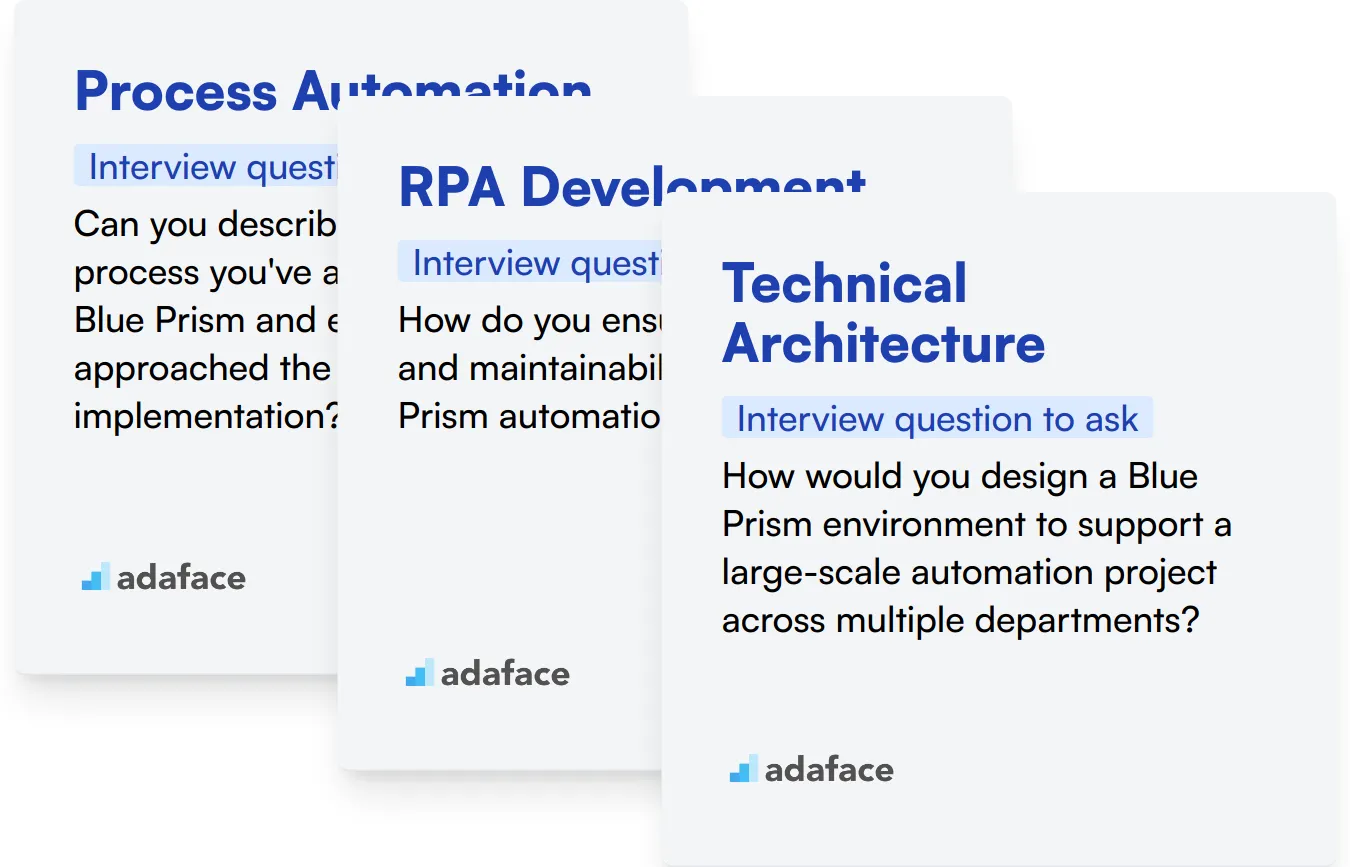
Process Automation
Process Automation is the cornerstone of Blue Prism. It involves designing and implementing automated workflows to streamline business operations and increase efficiency.
To evaluate this skill, consider using an assessment test with relevant multiple-choice questions. These can help filter candidates based on their understanding of process automation concepts.
During the interview, you can ask targeted questions to gauge the candidate's experience with process automation. Here's an example:
Can you describe a complex process you've automated using Blue Prism and explain how you approached the design and implementation?
Look for answers that demonstrate a clear understanding of process analysis, logical thinking, and the ability to translate business requirements into automated solutions. The candidate should explain their approach to breaking down the process, identifying automation opportunities, and implementing the solution using Blue Prism tools.
RPA Development
RPA Development skills are essential for creating and maintaining Blue Prism automations. This includes proficiency in Blue Prism's development environment and best practices for building robust, scalable solutions.
An RPA online test can be useful to assess a candidate's knowledge of RPA development concepts and Blue Prism-specific features.
To evaluate RPA development skills in an interview setting, consider asking:
How do you ensure the reliability and maintainability of the Blue Prism automations you develop?
A strong answer should cover aspects such as modular design, error handling, logging, and version control. Look for candidates who emphasize the importance of creating reusable objects, implementing proper exception handling, and following Blue Prism best practices for maintainable code.
Technical Architecture
Understanding Blue Prism's technical architecture is crucial for designing scalable and efficient automation solutions. This includes knowledge of Blue Prism's components, infrastructure requirements, and integration capabilities.
To assess a candidate's grasp of Blue Prism's technical architecture, you might ask:
How would you design a Blue Prism environment to support a large-scale automation project across multiple departments?
Look for answers that demonstrate an understanding of Blue Prism's architecture components such as runtime resources, application servers, and databases. The candidate should discuss considerations like scalability, security, and integration with existing systems. They might also mention strategies for load balancing and disaster recovery.
3 Tips for Using Blue Prism Interview Questions
Before you start putting what you've learned to use, here are our tips for making the most out of Blue Prism interview questions.
1. Integrate Skills Tests Before Interviews
Using skills tests before the interview phase can help you filter out candidates who don't meet the baseline requirements, saving you time and effort.
Tests like the Blue Prism Test can be employed to gauge a candidate’s fundamental understanding and capability in Blue Prism.
The benefits are clear: it ensures only qualified candidates make it to the interview stage, thus streamlining your hiring process.
2. Curate a List of Concise and Relevant Interview Questions
Time during interviews is limited, so it is important to have a well-curated list of questions to evaluate candidates effectively.
Consider including questions from different domains such as JavaScript, Data Structures, or even soft skills like communication.
This approach ensures that you cover multiple aspects of a candidate's profile, giving you a holistic view of their capabilities.
3. Incorporate Follow-Up Questions for Depth
Using pre-set interview questions alone won't always be enough. Follow-up questions help you verify the depth of a candidate's knowledge.
For instance, if a candidate answers a question about Blue Prism's Object Studio, a good follow-up might be: 'Can you describe a challenging scenario you faced using Object Studio and how you resolved it?' This helps you gauge their practical experience and problem-solving skills.
Hire skilled Blue Prism developers with interview questions and skills tests
When hiring Blue Prism developers, it's important to accurately assess their skills. A quick and effective way to do this is by using a Blue Prism skills test. This test helps you evaluate candidates' knowledge and abilities objectively.
After using the skills test to shortlist top applicants, you can invite them for interviews. To streamline your hiring process and find the best Blue Prism talent, consider using our online assessment platform. It offers a range of tools to help you make informed hiring decisions.
Blue Prism Assessment Test
Download Blue Prism interview questions template in multiple formats
Blue Prism Interview Questions FAQs
Blue Prism is used for robotic process automation (RPA) to automate repetitive tasks and enhance operational efficiency.
Review key concepts and practice common interview questions about process automation and technical architecture in Blue Prism.
Look for skills in process automation, understanding of Blue Prism architecture, problem-solving abilities, and experience with similar tools.
Yes, Blue Prism can be integrated with multiple systems using APIs, web services, and other technological interfaces.
The stages include planning, designing, developing, testing, deployment, and maintenance of the automated processes.
While Blue Prism is designed to be a low-code platform, some coding knowledge can be beneficial for customizations and complex automations.

40 min skill tests.
No trick questions.
Accurate shortlisting.
We make it easy for you to find the best candidates in your pipeline with a 40 min skills test.
Try for freeRelated posts
Free resources




